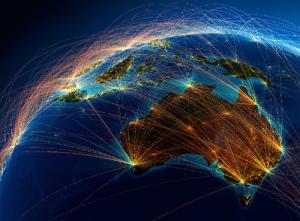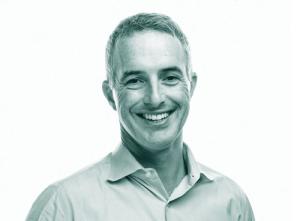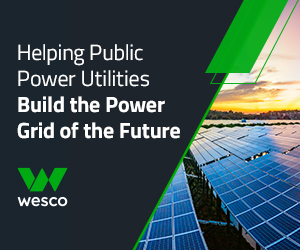Neara
Jack Curtis is the Chief Commercial Officer of Neara.
Neara is taking all its experience on improving reliability and resiliency of critical infrastructure learned in Australia and bringing it to America, as the energy and utilities industry undergoes a massive transformation here. The company, through digitization, is on a journey to help utilities solve big problems.

Utilities in all countries are grappling with storms, wildfires, and more. Neara is here to help, removing some of the safety risk that goes along with such issues, by providing unique insights into them via digital twinning.
PUF sat down with an expert on how all this technology works, Neara's Jack Curtis, Chief Commercial Officer, who explains what this journey is, and where it is going, now that Neara has traveled from its home in Australia to come to America.
PUF's Steve Mitnick: Jack, you're busy. What's going on?
Jack Curtis: It's been exceptionally busy. In the Australian state in which I live, New South Wales, which is roughly the same size as the state of Texas, we're experiencing one in a thousand-year floods. Last year, we had one in a hundred-year floods. We're living an unfortunate reality of these floods becoming more intense and more frequent.
 Jack Curtis: Neara’s technology is helping them understand where to power down the network to avoid significant safety issues. Once the flood waters recede, it shows when they can safely restore power to communities.
Jack Curtis: Neara’s technology is helping them understand where to power down the network to avoid significant safety issues. Once the flood waters recede, it shows when they can safely restore power to communities.
Our New South Wales customers, who collectively own and operate the entire distribution network in the state, are using our platform to model the impacts of floods on devastated communities. Neara's technology is helping them understand where to power down the network to avoid significant safety issues. Once the flood waters recede, it shows when they can safely restore power to communities.
We are seeing the platform's ability to provide highly accurate guidance that is faster than teams in the field, which in the future can be used to reduce the binary safety risk exposure of having those teams in the field at all.
We had an example with one of our utility customers where Neara's platform informed them that the water was five hundred centimeters — or about two hundred inches — away from the power lines in a high customer concentration area, so the utility deactivated the power.
An hour later, a person in the field rang the utility's operations center and said, turn down the power, it's getting close. They said, Neara already flagged us to do that.
This is a great example of the accuracy Neara's technology provides, and also demonstrates that utilities don't need to have people in the field exposed to safety risks when you have that same level of fidelity in a digital model.
PUF: Which utilities companies are you working with? Is Endeavour one of those?
Jack Curtis: Yes, Endeavour Energy is one, and one of the most affected by the floods. Essential Energy owns a lot of the northern rural networks in the state. The other main customer of ours in New South Wales is Ausgrid and they own all the metropolitan infrastructure, which isn't as impacted.
We're at a point now where all of New South Wales' distribution network is, or is close to, being modeled on our platform. This means that when there are statewide disasters, whether it's floods, storms, or wildfires, we can model the infrastructure impact at a statewide level, not just a utility-specific level.
PUF: Is this a digital twin of the distribution system?
Jack Curtis: Yes, it essentially looks like the arterial profile of a body. When you map it out at a high level, it's everywhere, across a massive amount of land, across thousands of miles of network infrastructure, and millions of assets. What our platform does, is it automatically digitizes and analyzes all of it.
It takes GIS data, LiDAR data, and provides utilities with an engineering-grade, 3D understanding of their network and assets. It's not just, here's a visualization of your network and of a flood, which looks nice. It's saying, this is what's going to happen when that flood hits your network.
You'll understand whether it's going to make power lines fall over, and whether they're going to fall into people's properties. It's going to give you a sense of the structural integrity of the network. Most important, in the context of safety, risk, and disaster response, it shows where you should be shutting down power, so it doesn't affect communities.
With these floods, what used to be an anomaly event is now an annual event. We are seeing the same with bushfires, which is our equivalent to wildfires. There used to be a one-in-fifty-year wildfire and now, it's wildfire season every year.
For utilities, this poses real challenges. How are we going to manage it this year? How are we going to mitigate it? How are we going to avoid having thousands of people in the field, trying to identify what's going to happen and then react to it when it does?
PUF: It seems the mission of digitizing your grid is for resilience, whether it's flooding, bushfires, maybe others, like acts of nature.
Jack Curtis: At one critical level, yes. It spans any kind of weather event — wildfire, flood, storm, hurricanes, you name it. Because our platform is a physics-based platform, it can understand the impact of any external events on the network infrastructure.
With respect to resiliency, we focus across three lenses of disaster response or weather impact. The first is providing owners of critical infrastructure the ability to predict what's going to happen.
The Neara platform can essentially simulate what's going to happen if, for example, a certain category hurricane comes through. It can show what damage is going to be inflicted on critical infrastructure. Then, it can provide insights, such as, here are the areas of your network most prone to weakness.
Therefore, if you spend money in laser-focused, high-risk areas, instead of gold plating the entire network, there's a strong chance you can avoid spending ten times that on the back end once the weather event occurs. It's a preemptive network resiliency solution that not only reduces the risk of negative network impact when an event occurs, but also significantly improves the cost of doing so, both for the utility and the utility's customers.
The second lens is when an event is occurring, we can help manage the safety and risk component more effectively, instead of, for example, having someone in the field standing in a pool of water next to an electricity line, saying, it's about to be submerged by flood water.
We can take that person out of the field and manage the risk digitally, including more efficiently and more accurately. When the event's passed, Neara can provide guidance as to when and where it's safe to restore power to customers.
The third lens is the rectification side. If a network has incurred a hundred million dollars of damage due to a flood or a storm or a hurricane, Neara's platform can inform how to repair the network more cost-effectively, without compromising resiliency for the next event. It's essentially an entire life-cycle solution of weather impact, disaster response, and network resiliency optimization.
PUF: What do you mean by physics-based platform?
Jack Curtis: Our platform leverages a number of critical building blocks, including finite element analysis functionality. The digital twin industry has become a broad church.
Where we play within digital twin land is, yes, there's a digitization of assets, a visualization of your network, but that captures a lot of participants in the space. Where we differentiate is at that physics-enabled level, which is, your network will behave digitally, like it would in the real world. What you simulate in a Neara digital model can be deployed on the physical network with a very high degree of confidence.
You can simulate wind coming through, and it'll show conductors swaying and the structural integrity of the asset changing.
It'll show that a pole or tower was at ninety-eight percent structural capability and now it's at a hundred and twenty percent. It's going to be overloaded and going to collapse. That's going to create a cascading asset failure within a certain section of the network.
We like to say that what's going to happen in the real world can be simulated in the digital world first. To date, that's been very hard to do. To the extent it has been done, it's been done at an individual asset level. If you want to understand what's going to happen to one pole or one tower, there is software that can enable you to do that.
If you want to understand what's going to happen across thousands of assets and thousands of miles of network, that'll take you literally six years. We're doing it in real time. That is the uniqueness of Neara's digital model. It provides that level of engineering, physics-grade fidelity and understanding, but you can simulate it at network-wide scale, and at a much greater velocity.
PUF: Is it only for a big utility, with a lot of in-house talent to understand how to put it together and use it?
Jack Curtis: Certainly not. There is an element of working with customers to build the model. We spend about a month taking all their data, whether it's GIS data, LiDAR, or asset registry information. We take all relevant network data and build the digital model, ninety-five percent of which is done automatically.
While we're doing that, we're training the customer on how to use the platform. Once we've built the model, they're able to access whatever use case they want, whether it's vegetation management, network resiliency, disaster response, or any number of other use cases our platform supports. Our goal is not to have a black box software solution, where customers provide inputs, and we provide outputs.
By the time it's set up, they're using it and running analyses or writing formulas. The formula function is the equivalent of basic Excel. They can say, if a wind of this velocity comes through, then identify this part of the network that's going to react. It's a self-service platform once the initial setup is complete.
PUF: Beyond Australia, have you thought about trying to involve utilities outside of New South Wales?
Jack Curtis: Yes. We're well into that journey. We've now digitally modeled close to sixty percent of all of Australia's electricity's grid. It's a large amount. Last year, we set up our U.S. operations and that's a big focus for us this year and going forward.
What we've found encouraging is the challenges we've solved and validated for utilities domestically, and at a meaningful level of differentiation, are the same problems U.S. utilities are facing — just at larger scale and, quite frankly, graver.
The bushfire work we've done for Australian utilities is highly analogous to the issues California utilities are experiencing. A lot of what we're doing in the storm, flood, hurricane context on the east coast of Australia is highly analogous with the east coast of the U.S.
We are encouraged that this doesn't require building new functionality. It's what we've done here, transplanted to the U.S., but at much larger scale and greater severity.
PUF: Do you have some of that now? That could really expand.
Jack Curtis: Yes, we do. That's what we've seen in Australia, where last year, the floods didn't impact Essential Energy, but they impacted Endeavour. This year, they've been so bad they impacted both utilities and Endeavour offered their help to Essential.
That's the great thing about the electric utilities industry because these large companies inherently don't compete. When they are on to something that benefits the industry, they evangelize it to each other, help adopt it, and accelerate it.
We are getting toward the end of that journey in Australia, where now, the utility evangelism and compound adoption is rolling through. We're at the beginning of that journey in the U.S. where those first couple of anchor customers we can deploy the same functionality to, will, we believe, drive a similar dynamic.
PUF: You were one of the senior people at First Solar.
Jack Curtis: Yes, I was at First Solar for twelve years. I started in the U.S. on a journey with renewables that is similar to the one we are now on with the digitization of infrastructure for utilities. I saw the evolution of renewables adoption go from being niche to what it is today.
When I joined Neara, I viewed that as the next frontier for utilities. Which is, how do we digitize all this, so we can accelerate adoption of renewables, the connectivity of renewables? Then, make the network more resilient, safer, while reducing the amount of money needed to do that?
PUF: How do you want to progress, and do you have a roadmap on how to grow?
Jack Curtis: We want to progress in two areas. One is taking what we've done well here internationally, with a focus on North America initially. This year, we'll start to expand into Europe.
The other lens is our platform has focused, to date, on electric utilities. Largely because the problems we can solve there are so meaningful. But we've already started to look at adjacent infrastructure that exhibits a similar profile. That is, distributed, linear infrastructure comprising millions of individual assets, and difficult to optimize at network scale.
No software to date has been able to optimize across millions of assets at a large scale. We're starting to explore areas like telecommunications, particularly in the context of 5G network rollout. And areas like gas distribution pipelines, given our platform now has underground functionality.
We're in this balance between international expansion in electric utilities, which is the first priority, and then exploring where we can add similar value in adjacent infrastructure verticals. Regardless, we want to be confident we are massively moving the meter for our customers.
Because the platform's functionality can solve ninety-nine problems, we want to make sure we're solving the biggest-value problems for our customers. Whether it's safety, risk, cost, or customer impact.
If we're not, we're like, why are we solving the fourteenth-highest value problem when we should be solving the first five? We want to make sure everything we do is creating the greatest amount of value for customers. Then, making sure we're taking the platform in the proper direction to achieve that.
PUF: What's most rewarding for you?
Jack Curtis: When I joined First Solar, I was intent on joining a company that could make a difference. That was when renewables was in its infancy. First Solar, I thought, could pioneer the adoption of large-scale solar.
When I left First Solar, renewables had reached a point of mass adoption. I then asked, where in critical infrastructure do I think the next industry difference can be made? Particularly around reliance, safety, impact on community. I concluded that digitization is the next frontier.
I spent a lot of time trying to find the right solution and the right platform I thought could take the industry to the next level. Neara is dramatically increasing reliability and resiliency of critical infrastructure. In these current disaster contexts, the human impact of watching some of the flood footage from the New South Wales is heartbreaking.
It's all about how we can move this industry forward, while making sure the community impact piece of it can be improved as well. We're not just focused on delivering pin-pointed solutions; our view and approach is a holistic one in order to provide the greatest value and impact.




